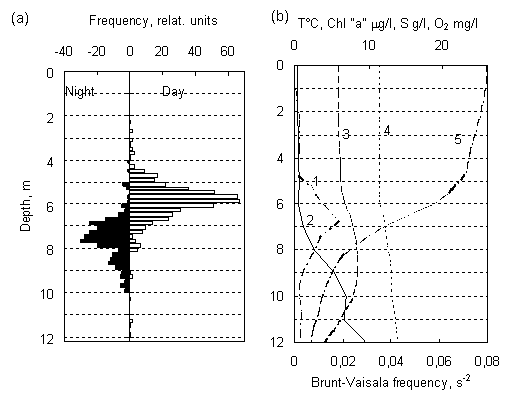 |
||||
 |
||||
|
|
|
|
|
|
|
|
|
|
|
|
|
|
2005
Physico-chemical monitoring and mathematical modeling (made at IBP SB RAS and ICS SB RAS):
It was shown that in 2005 the nature of the vertical distributions of the physico-chemical properties of lakes Shira and Shunet in summer didn't differ much from the previous years. It was revealed that in lake Shira in winter time the depth of the chemocline zone (the border of aerobic and anaerobic zones) can be substantially different in different years: in 2003 - 15.5 m, in 2004 and 2005 - about 11.5 m. In Lake Shunet the seasonal dynamics of stratification remained almost unchanged over several years, including 2005.
Modifications were made to the mathematical model of plankton vertical distribution in a stratified lake. In particular, a depth heterogeneous turbulent diffusion coefficient was introduced. The heterogeneity was modeled in the form of a "step" located at the chemocline depth, which reflects the real situation in a stratified water body. Secondly, the rates of the photosynthesis processes (oxic and anoxic), chemosynthesis and sulphate-reduction were calculated simultaneously with the biomasses of the corresponding bacteria. It was made for comparison of the estimated rates with the field data. As a result, the model adequacy degree was increased. The satisfactory coincidences of values and distributions of the process estimated rates with the field data were obtained for a quasi-stationary case.

Fig. Vertical distributions of bacterial sulphate-reduction rates in lake Shira : a) field data, obtained by isotopic method (Kosolapov et al., 2003); b) model analysis.
Trial calculations were made according to the one-dimensional mathematical model of the thermal and salt annual regimes of lakes Shira and Shunet.
An efficient numerical algorithm was worked out for calculation of the hydrophysical and hydrobiological characteristics of Lake Shira on coarse grid by contour line. Trial calculations were made.
Microbiological investigations (made at IBP SB RAS, IMB RAS and IBIW RAS ):
During the regular stage of the whole-year monitoring and comparison of its results with the data of the years 2002, 2003 and 2004 it was shown that the qualitative pattern of the seasonal dynamics of purple bacteria distribution in the investigated lakes repeated. In particular, in winter time the populations of purple bacteria in both lakes were by an order of magnitude less than in summer. The vertical distribution of bacteria was characterized by the presence of peak in the redox zone in summer time in both lakes. In Lake Shira in winter time the peak was absent, instead there was a proportional increase of the population of purple bacteria in the direction towards the bottom. In Lake Shunet the peak remains in winter time, but a certain "smearing" of the peak is also observed towards the bottom. Meanwhile, the absolute numbers in lakes Shira and Shunet differ approximately by two orders of magnitude: in Shira the number of purple bacteria reaches about 10 6 cells/ml in winter, and in summer 10 5 cells/ml. In Lake Shunet the corresponding figures are: in summer - - 10 8 cells/ml, in winter 10 7 - 10 6 cells/ml.
It was shown that in Lake Shunet green sulfur bacteria form the population peak in the layer about 5 cm immediately under the layer of purple bacteria, such stratification remaining in winter time, too. The populations of green sulfur bacteria were about 10 7 cells/ml in summer and 10 6 cells/ml in winter.
It was demonstrated that in the chemocline of Lake Shunet chemotrophic bacteria form the population peak about 10 9 cells/ml in the form of a thin layer which coincides in depth with the population peak of purple sulfur bacteria. These bacteria supposedly belong to chemolitotrophs, oxidizing reduced sulfur compounds.
The nucleotide sequence of gene 16S ðÐÍÊ for purple sulfur bacteria strain from Lake Shira was determined and entered into the world database EMBL/GenBank (under number AG633676). The strain was identified as Amoebobacter roseus (97.92 % homology).

Fig. Phylogenetic analysis of affinity between the strain IBP-Shira AG633676 and closely-related strain. The bar shows the scale of dissimilarity in the content of different nucleotide
.
Protoozoological investigations (made at IBP SB RAS):
The seasonal monitoring of the dynamics of the protozoan community of the pelagic and chemocline zones was conducted in Lake Shunet in winter, spring and autumn. The population and biomass of the main components of chemocline zone microzooplankton was determined during these periods. The binding of the main bulk of protozooplankton to the chemocline zone was shown.
Investigation was made of the day's production of microzooplankton of the chemocline zone in Lake Shunet in summer. Positive growth rate was only observed in the chemocline zone layers with purple bacteria ( 2,37 - 5,22 day -1 ). Positive production of infusoria was discovered in the layers above the chemocline zone (6,2 - 17,0 day -1 ).
The following infusoria cultures: Cyclidium sp., Euplotis sp., Prorodon ellipticus and flagellate Cryptomonas salina were singled out from the chemocline zone of Lake Shunet for the experiments aimed at the investigation of chemocline ecosystem in laboratory model variants.
Investigations of phyto- and zooplankton (made at IBP SB RAS and KSU):
The following investigations were made: the video observation of the day and night spacial distribution of Gammarus lacustris in Lake Shira, the full-scale experiment aimed at the determination of trophic provision of G.lacustris in the pelagic zone, the analysis of the fatty acid composition of Gammarus' stomachs and bodies and possible sources of its food in the littoral and pelagic zones. The specific population maximum of Gammarus was registered in the central part of the lake in daytime, in the narrow layer at a depth of 5-6 m. At night this layer goes down and becomes less pronounced. The comparison of the vertical distribution of Gammarus population with the environmental factors shows that Gammarus occupies the metalimnion (termocline) zone. The insignificant difference between the location of the day and night maximums (about 1.5 m) proves that their vertical migration activity isn't very intense. A possible advantage of being in the metalimnion zone is its hydrodynamic stability ( Brunt Vaisala frequency has the maximal value). This zone is where the sinking phyto- and zoodetritus is accumulated. Given that Gammarus is a benthic species and is badly adapted for the life in the pelagic zone, its hydrodynamic stability can be of vital importance for moving and search of food.

Fig. Vertical distributions of the frequency of occurrence of Gammarus lacustris ( à ) and physico-chemical factors (b) in the pelagic zone of Lake Shira (2005). 1- Brunt Vaisala frequency, 2 - Chlorophyll ; 3 - oxygen; 4 - salinity; 5 - temperature.
The video observation data indicate that it is more likely that occupation of the pelagic zone has a seasonal character, connected with the ontogenetic development of Gammarus, rather than consequence of the division of the population on littoral and deepwater groups. Meanwhile, the time that Gammarus spends in isolation from the bottom can be rather long. This is proved by the trophic experiment in which a certain number of Gammarus lacustris was kept in the pelagic zone during 20 days on the natural plankton of the lake. A reliable biomass gain of Gammarus was registered (0,014 mg dry weight/specimen·day), the death rate in the experiment varied from 10 to 20 %. To ascertain if there is a possibility for this species to exist in such experiments on internal supplies, a control experiment was conducted with filtered water. In this experiment the death rate was 100 %. The trophic experiment demonstrates both the potential ability of pelagic plankton to satisfy the food demand of Gammarus, and the fact that plankton is the main feed source for Gammarus in the pelagic zone.
At the same time it was shown that the fatty acid composition of the stomachs and bodies of the animals caught in the pelagic and littoral zones was almost the same. Absence of differences might be an indirect proof of 1) the "unity" of Gammarus population and 2) the presence of horizontal migrations in the lake. It should also be noted that the insignificant contribution of bottom sediments to the nutrition spectrum of Gammarus in Lake Shira indicated a high feeding selectiveness. Thus, it was revealed that for a comparatively small lake such as Shira the adaptation of Gammarus to the pelagic mode of life has probably an ontogenetic (or a seasonal?) nature and doesn't affect the subpopulation formation level. It is significant that the registered local adaptation of G.lacustris (existence in the pelagic zone not typical for benthic species) in Lake Shira , in the absence of consumer link of the second order (fish), extends the ecological niche of this species.
Bioluminescent testing of lake water (made at IBP SB RAS):
To analyze the possible mechanisms of the effect of water components of lakes Shira and Shunet a study was made of the patterns of influence of inorganic compounds containing sulfur of different oxidation degrees on bioluminescent bienzymatic system. It was shown that bioluminescence activation and inhibition in the presence of sulfur compounds are connected with their effect on the reduction processes taking place in the bioluminescent system, and are determined by the concentration and redox properties of sulfur compounds.
Investigation was made of the effect of water samples, taken from Lake Shira along the coastline and from the depth, on the bioluminescence of the bienzymatic system with quinone. It was revealed that the effect of the water from a saline water body leads to the activation of bioassay bioluminescence, and using of additional kinetic bioluminescence parameters, such as induction time ( Ò ) and time of transition to luminescence maximum (t max ), allows to divide the lake into zones which differ by their oxidation-reduction properties. In this way, the reduction of luminescence delay parameters ( Ò è t max ) was registered in several regions of the coastal area (samples taken in the places of forest area underflooding), which indicates the presence of redox-active pollutants in these water samples. Investigation of deep water samples, beginning with the depth of 11 m ( Lake Shira ), showed that the increase of hydrogen sulphide concentration led to the decrease of the parameters Ò è t max . It was established that t max is more sensitive to the alteration of water properties than Ò .
The high sensitivity of bioluminescent bioassays to the effect of the water from Lake Shunet was demonstrated. The comparison of the effect of water from a salt lake on various test systems showed that the bioluminescent bienzymatic system with quinone is not only more sensitive to the alteration of water quality than the bienzymatic system and luminescent bacteria, but is also specific to the alteration of redox properties of the lake water.
Thus, adaptation of the new bioluminescent bioassay based on the use of bienzymatic system with quinone was made for testing of the water of lakes Shira and Shunet.
and special program of the Presidium of Siberian Branch of Russia an Academy of Sciences.
Akademgorodok 660036 Krasnoyarsk, Russia
Phone: (3912) 431579 Fax: (3912) 433400
e-mail: ibp@ibp.ru
webmaster: maxim@ibp.ru
http://www.ibp.ru